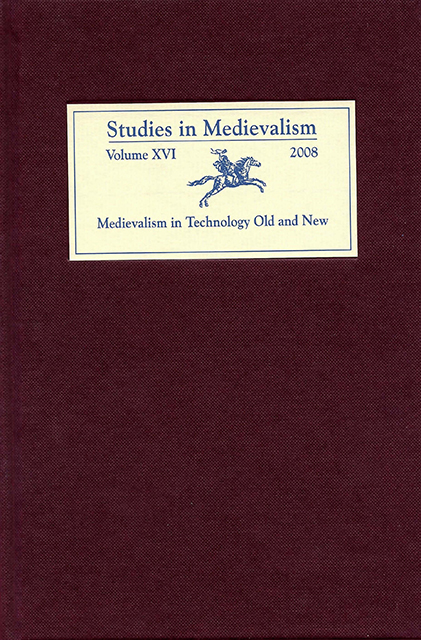Book contents
- Frontmatter
- Studies in Medievalism
- Acknowledgments
- Contents
- Volume XVI 2008
- Illustrations
- Editorial Note
- Contes du Style des Troubadours: The Memory of the Medieval in Seventeenth-Century French Fairy Tales
- A Ritual Failure: The Eglinton Tournament, the Victorian Medieval Revival, and Victorian Ritual Culture
- An Eastern Medieval Revival: Byzantine Art and Nineteenth-Century French Painting
- I Am Weary of That Foolish Tale: Yeatss Revision of Tennysons Idylls and Ideals in Time and the Witch Vivien
- The Doughboy Comes to Chartres: Stars and Stripes and the Middle Ages
- Constructing Difference: The Guidonian Hand and the Musical Space of Historical Others
- An Introduction to Medievalist Video Games
- Medieval and Pseudo-Medieval Elements in Computer Role-Playing Games: Use and Interactivity
- Romancing the Game: Magic, Writing, and the Feminine in Neverwinter Nights
- Revising the Future: The Medieval Self and the Sovereign Ethics of Empire in Star Wars: Knights of the Old Republic
- Promises of Monsters: The Rethinking of Gender in MMORPGs
- Contributors
Medieval and Pseudo-Medieval Elements in Computer Role-Playing Games: Use and Interactivity
Published online by Cambridge University Press: 10 March 2023
- Frontmatter
- Studies in Medievalism
- Acknowledgments
- Contents
- Volume XVI 2008
- Illustrations
- Editorial Note
- Contes du Style des Troubadours: The Memory of the Medieval in Seventeenth-Century French Fairy Tales
- A Ritual Failure: The Eglinton Tournament, the Victorian Medieval Revival, and Victorian Ritual Culture
- An Eastern Medieval Revival: Byzantine Art and Nineteenth-Century French Painting
- I Am Weary of That Foolish Tale: Yeatss Revision of Tennysons Idylls and Ideals in Time and the Witch Vivien
- The Doughboy Comes to Chartres: Stars and Stripes and the Middle Ages
- Constructing Difference: The Guidonian Hand and the Musical Space of Historical Others
- An Introduction to Medievalist Video Games
- Medieval and Pseudo-Medieval Elements in Computer Role-Playing Games: Use and Interactivity
- Romancing the Game: Magic, Writing, and the Feminine in Neverwinter Nights
- Revising the Future: The Medieval Self and the Sovereign Ethics of Empire in Star Wars: Knights of the Old Republic
- Promises of Monsters: The Rethinking of Gender in MMORPGs
- Contributors
Summary
Introduction
The Middle Ages have long served as an inspiration for film and literary works. However, since the late twentieth century, they have also fueled an ever-growing number of re-enactments and games, especially computer games. Some of the latter are grounded in thorough research on the historical circumstances of the Middle Ages, but many more depend on overt fiction from or about the period, and almost all incorporate at least some pseudo-medieval elements.
This article explores some of those medieval and pseudo-medieval elements, as well as the types of computer game in which they appear. As the number of these games is far greater than could reasonably be covered here, I will focus on those that revolve around role-playing. But to give some idea of the range of medievalism and pseudo-medievalism in computer games as a whole, I will address examples from three different subgenres of roleplaying games. After briefly outlining the genre as a whole – as well as some of the others into which computer games have traditionally been divided – I will summarize Starbreeze Studios’ Knights of the Temple: Infernal Crusade, which represents simple, action-based games set in comparatively historical circumstances, Piranha Bytes’ Gothic 2, which is a more complex, questbased game set in a fantasy locale with mere overtones of the Middle Ages, and Mythic's Dark Age of Camelot, which is a massively multiplayer on-line role-playing game (henceforth referred to as an “MMORPG”) set in a milieu largely derived from medieval fiction. I will then examine three key aspects in the development of these games – namely, the medieval themes that apparently served as their inspiration, the manner in which these conceptions were altered for the benefit of the games (and the motives behind these alterations), and the differences among anticipated levels of interaction in the games – before concluding with a summary of my main points.
The Types of Computer Game Containing Medieval Elements
As is suggested by the vast differences among the genres and subgenres to which specialty publications often assign the same computer games, categorizing the latter can be highly problematic. Games from one genre often contain features associated with other genres, and some features are found in almost all genres. For example, games that fundamentally revolve around role-playing almost always contain at least some form of action, strategy, and/or adventure, and at least some form of role-playing is almost always found in games that fundamentally revolve around action, strategy, and/or adventure.
- Type
- Chapter
- Information
- Studies in Medievalism XVIMedievalism in Technology Old and New, pp. 125 - 142Publisher: Boydell & BrewerPrint publication year: 2008
- 3
- Cited by



